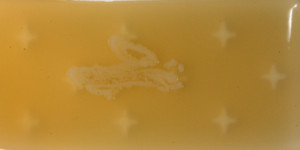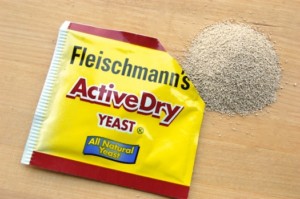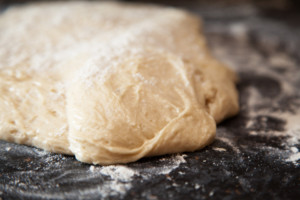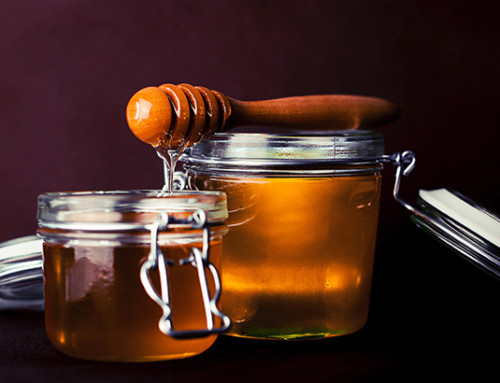Fact: we love food, and we love science. So, when the two come together, we get excited. Making bread is actually a very scientific adventure because it involves microbiology and chemistry, and much of that is due to yeast! We know yeast plays a crucial role in break-making, but let’s look at what exactly that is and why.
Yeast are single-celled organisms, specifically, from the fungi family. Yeast cells are egg-shaped and can only be seen under a microscope. There are about 160 species of yeast, but bakers use a specific type of yeast, known as Saccharomyces cerevisiae, or “sugar-eating fungus”. Although small, this species of yeast is very strong and capable of fermentation, which is the process that causes bread dough to rise.
Below is an image of Saccharomyces cerevisiae growing on a dipslide with Malt agar:

The Fermentation Process
Yeast cells digest food to obtain energy for growth, and they are so successful in baking because they love sugar. As we know from our Glucose test strip experiments, there are different types of sugars: sucrose (beet or cane sugar), fructose and glucose (from fruit, honey, molasses, syrup, etc.), and maltose (derived from starch in flour).
 Many of us have used yeast in the store-bought form: little white packets containing beige granules. The yeast in these packets remains dormant until it comes into contact with warm water. Once reactivated, it begins feeding on the sugars in the flour and other added sugars, releasing the carbon dioxide that makes bread rise. Let’s look a little closer at the logistics of this process.
Many of us have used yeast in the store-bought form: little white packets containing beige granules. The yeast in these packets remains dormant until it comes into contact with warm water. Once reactivated, it begins feeding on the sugars in the flour and other added sugars, releasing the carbon dioxide that makes bread rise. Let’s look a little closer at the logistics of this process.
You might be thinking, wait a minute, flour has sugar in it? Then, why do we add more cane sugar to bread dough? Flour is made up of about 70% starch by weight, which also contributes to the process. When starch particles are attacked by enzymes in flour, they release the sugars that yeast feeds on.
The process of fermentation produces not only carbon dioxide, but also ethyl alcohol, which as you know, is how beer is made. As the carbon dioxide is released into the liquid bread dough, it can’t escape due to the dough’s elasticity. Thus, the expanding gas is trapped in the dough, causing it to rise. The ethyl alcohol produced by yeast during fermentation contributes to the flavor and aroma of the bread, but it also evaporates during baking, contributing to the gas bubbles helping bread rise.
 Because the yeast feeds on sugars from the flour in bread dough, the type of flour used can also affect the outcome of the bread. Many of us probably have bleached flour on hand, but wheat flour is actually the most commonly used in bread-making. Wheat flour contains two different proteins, glutenin and gliadin, that when combined with water, form gluten. As you knead dough, an important step in the process, the gluten becomes stretchy and more elastic, filling with gas bubbles as the yeast begins to feast. The starch also plays an important role here. It reinforces the gluten and absorbs water during baking, which helps the gluten contain the pockets of gas produced by the yeast.
Because the yeast feeds on sugars from the flour in bread dough, the type of flour used can also affect the outcome of the bread. Many of us probably have bleached flour on hand, but wheat flour is actually the most commonly used in bread-making. Wheat flour contains two different proteins, glutenin and gliadin, that when combined with water, form gluten. As you knead dough, an important step in the process, the gluten becomes stretchy and more elastic, filling with gas bubbles as the yeast begins to feast. The starch also plays an important role here. It reinforces the gluten and absorbs water during baking, which helps the gluten contain the pockets of gas produced by the yeast.
When dough is finally baked in the oven, the yeast initially continues feeding, and the pockets of carbon dioxide gas continue to expand. However, as the temperature of the oven and the dough rises, the yeast eventually dies off, the gluten hardens, and the dough solidifies. And wa-la! Bread!
Other Baked Goods
So, why isn’t yeast used in all baked goods, like cookies or brownies? Well, some baked goods rely on the chemical reaction between an alkaline and an acidic compound to rise. Baking powder and/or baking soda are often used in baked goods, and both are alkaline substances containing sodium bicarbonate. When they are mixed with acidic ingredients, like brown sugar, lemon juice, buttermilk, cocoa powder, and so on, it creates gas, which makes the baked good rise.
Want to watch the science in action? Here’s an easy, homemade recipe for bread from Taste of Home. See if you can follow the science as you make the bread!







Leave A Comment